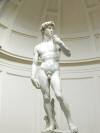
Neo-Classical Humanism and The Renaissance
Although Greek and Roman literature and art had been removed from bookshelves and display by The Church for roughly 1000 years, copies of these texts and statuary still existed and were studied in the Arabic Muslim world. Some of this was brought back into Europe with the Moorish invasion of Iberia (Portugal and Spain), but mainly it returns to Europe through Italian -- especially Venetian -- trade with the African and Middle Eastern world.
Respect for Greco-Roman architecture, however, had never waned, as every day Italians were faced with the decaying brilliance of their Roman ancestors. For example, the Pantheon
As Opposed to Medieval-Christian art, Greco-Roman literature and art shows an expression of wider love for man and nature
-- “Paganism”: Greek belief that soul and body are one: actions of the body naturally and properly expressed the humanity of the soul
-- The art is rooted in the original goodness of man (vs. original sin)
-- The Greeks had shown a relative tolerance for intellectual diversity, free thinking (Achilles and Agamemnon) expressed through democracy
-- Neo-Classical Humanism was NOT opposed to Christianity but viewed as correcting errors and excesses of Medieval church: it was an attempt to show that Greek and Christian VIRTUE are the one and the same. This was what Thomas Aquinas (1225-1274) had successfully attempted with Aristotle and Christian theology. In this way it is similar to the Reformation as both attempting address excesses and errors of the Church.
Michelangelo (1475-1564): Neo-Classical or Renaissance Humanism: A blending of Christian theology with Greco-Roman Aesthetics: the beauty of the human form, the divinity of man: man in God's image.
Michelangelo, The David, Uffizi Gallery, Florence Italy 1501-1504 (17 ft. tall)
Michelangelo: The Holy Family, Uffizi Gallery, Florence Italy c. 1503-1505
Michelangelo: Creation of Sun and Moon, Sistine Chapel, Vatican1508-1512
Michelangelo, ceiling, Sistine Chapel, Vatican 1508-1512